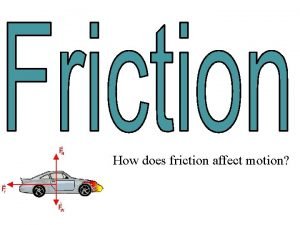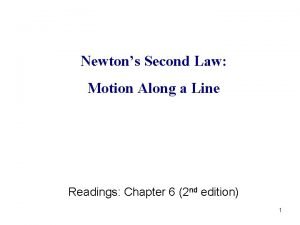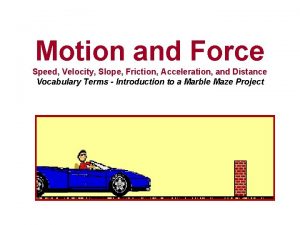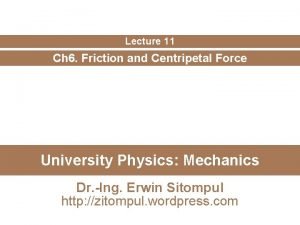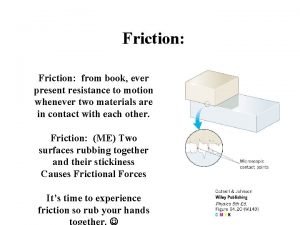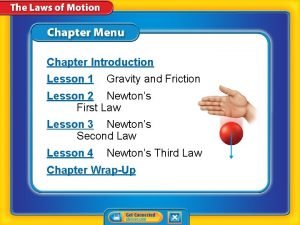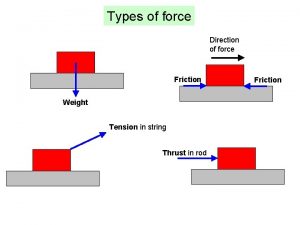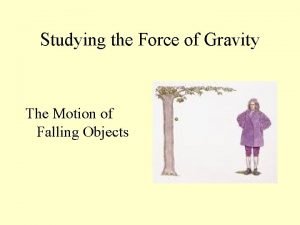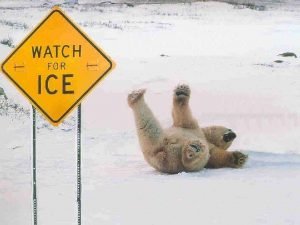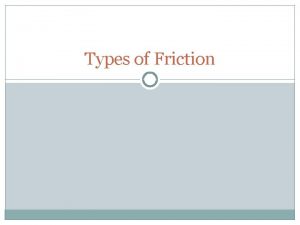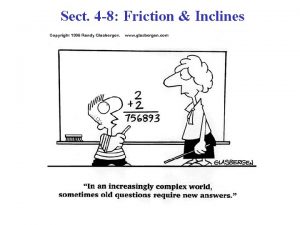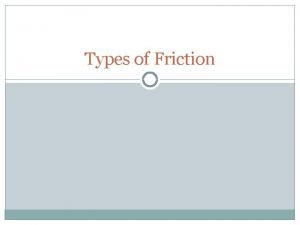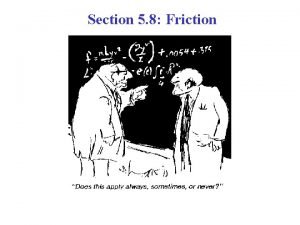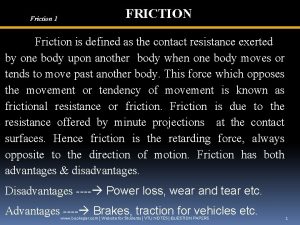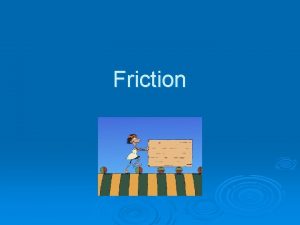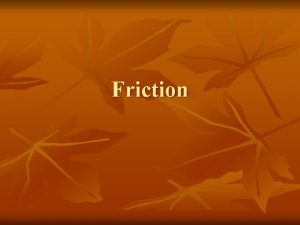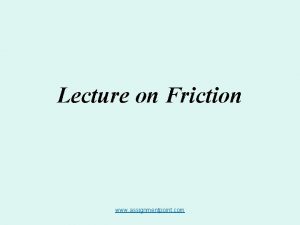Friction What is friction and what causes it























- Slides: 23

Friction • What is friction and what causes it? – Student Inquiry • Friction summary • Friction and Newton’s Laws • Static and Kinetic Friction • Coefficients of Friction • Applications of Friction

Friction • What causes friction? • What affects the amount of friction two objects experience? • Describe how your life would be different if friction didn’t exist.

Teach. With. Fergy Preview File Please enjoy this preview of your Student Version of the Power Point. - Some slides appear blank because they have been removed. - Student versions have portions of the text removed which is given in the teacher version and appear as ______ - Other slides may have. . . on them, this represents writing that has been removed. - Please note that the Entire Unit Package can also be purchased at a steep discount from my Store.

Friction • The analysis of friction is very important to practical situations since friction is present everywhere. • Friction is a good and bad thing. – Good when our tires meet the pavement – Bad when reducing efficiency and/or producing heat or slipping on ice

This slide has been removed

Friction • _____ – Kinetic friction – Static friction – Air resistance (drag friction or fluid friction)

Friction and Newton’s Laws • Friction is simply a force included and accounted for in a FBD. • Applies to situations where: – Fnet = 0 – Fnet = ma

Two types – Static and Kinetic • Static friction – _____ • Kinetic friction – _____ • The magnitude of friction depends on – the surfaces in contact with each other (ie. shoe and floor). – the weight of the object due to its mass.

This slide has been removed

Low Friction High Friction

Static Friction • The magnitude of the force needed to start a stationary object moving is the maximum static friction, FS • _______ • Which way is Fs acting in this picture?

This slide has been removed

Coefficients of Friction • The coefficient of friction is a ratio of the magnitude of the force of friction between two surfaces to the normal force between those surfaces. • Therefore: _______

Coefficients of Friction • Determining μS and μK for given substances is done through experimentation. • i. e.

Friction Application • Describe how both of these strategies improve driving safety in the winter.

This slide has been removed

Friction Application

Friction Applications Reducing Friction • How do each of the following reduce friction? • What is the result? • ______

This slide has been removed

Check Your Understanding In the horizontal starting area of a four-person bobsled race, the four athletes, with a combined mass including outfits of 295 kg, exert a minimum horizontal force of 41 N [fwd] (total) to get the 315 -kg sled to begin moving. After the sled has travelled for almost 15 m, all four people jump into the sled, and the sled then experiences a kinetic friction of magnitude 66 N. Determine the coefficient of a) static friction. b) kinetic friction.

Check Your Understanding Two people are pushing horizontally on a crate of mass 25 kg. One person is pushing from the right with a force of 50 N. One person is pushing from the left with a force of 80. 0 N. The coefficient of friction is 0. 05. Find the acceleration of the crate.

This slide has been removed

Check Your Understanding A 0. 17 kg hockey puck, sliding on an outdoor rink, has a velocity of 19 m/s [fwd] when it suddenly hits a rough patch of ice that is 5. 1 m across. Assume that the coefficient of kinetic friction between the puck and the rough ice is 0. 47. a) Draw a FBD of the puck moving on the rough ice. b) Calculate the kinetic friction acting on the puck. c) Determine the puck’s average acceleration while on the rough ice. d) Calculate the puck’s velocity as it leaves the rough ice and returns to the smooth ice (vf).
 Jill is climbing
Jill is climbing What causes friction
What causes friction What causes friction
What causes friction What causes friction
What causes friction Factors affecting friction
Factors affecting friction Ultimate vs proximate causation
Ultimate vs proximate causation Proximate behaviour in animals
Proximate behaviour in animals Causes and effects of the french and indian war
Causes and effects of the french and indian war Gravity and friction
Gravity and friction Find acceleration
Find acceleration Acceleration and friction
Acceleration and friction Static friction?
Static friction? Friction and centripetal force
Friction and centripetal force Friction spinning process
Friction spinning process Everpresent newton
Everpresent newton Air resistance
Air resistance Friction can act between two unmoving, touching surfaces.
Friction can act between two unmoving, touching surfaces. Bowden and tabor friction theory
Bowden and tabor friction theory Weight and friction
Weight and friction Coefficient of friction formula
Coefficient of friction formula Conduction induction and friction
Conduction induction and friction Friction with english and swedish neighbors
Friction with english and swedish neighbors Bearing bolts and friction grip bolts
Bearing bolts and friction grip bolts Gravitational force
Gravitational force



